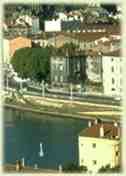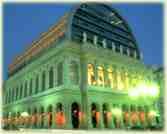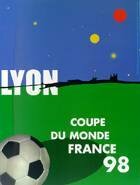
Capital of the Gauls
In 43 B.C., L.M. Plancus chose Fourvière, a hill dominating the Rhône river as it makes its way to the sea, as the site for founding "Lugdunum." The city, a younger sister to Rome, was built at a point where many roads met, and was also symbolic of a crossing of destinies. It became the capital of Gaul, and Lyon is nowadays the oldest Roman archeological site after Rome itself. The Old Town is one of the most important and well-preserved Renaissance sectors in Europe. But Lyon is also a silk capital, the place where the Jacquard method of weaving was invented, where manufacturers, merchants and silkweavers made the town famous throughout the world.
Lyon, economic focal point
 he capital of the Rhône-Alpes region has a unique position at the very centre of Europe, and as a large city possesses considerable industrial and business advantages. Numerous world-class companies and international institutions have set up their headquarters there, bringing the city into the front line among Europe's economic leaders. Its wide range of business sectors include metallurgy, electronics, chemistry, pharmaceutical products, biotechnology, the food industry, electricity, plastics technology and textiles, as well as banking and insurance, engineering, consultancy and communication. he capital of the Rhône-Alpes region has a unique position at the very centre of Europe, and as a large city possesses considerable industrial and business advantages. Numerous world-class companies and international institutions have set up their headquarters there, bringing the city into the front line among Europe's economic leaders. Its wide range of business sectors include metallurgy, electronics, chemistry, pharmaceutical products, biotechnology, the food industry, electricity, plastics technology and textiles, as well as banking and insurance, engineering, consultancy and communication.

Lyon, the art of living well
 yon owes its distinctive character to its surroundings, which include two steep hills, a vast plain and two rivers. During the last decade, the city has become even more handsome, transforming and improving its squares and gardens, and implementing a lighting strategy to show off its finest features: 150 points of interest are now illuminated each night. A strategy which has been exported elsewhere throughout the world with great success, for the Hermitage in St. Petersburg, the city of Jerusalem, and recently Havana have all benefited from Lyon's expertise in this respect. yon owes its distinctive character to its surroundings, which include two steep hills, a vast plain and two rivers. During the last decade, the city has become even more handsome, transforming and improving its squares and gardens, and implementing a lighting strategy to show off its finest features: 150 points of interest are now illuminated each night. A strategy which has been exported elsewhere throughout the world with great success, for the Hermitage in St. Petersburg, the city of Jerusalem, and recently Havana have all benefited from Lyon's expertise in this respect.
More than 4 million tourists visit Lyon each year, enticed by its many aesthetic pleasures and famous cuisine, spear-headed by Paul Bocuse and also to be found in the city's "bouchons," little picturesque restaurants offering a wide range of Lyon specialties.
Cultural metropolis
 yon is the place where cinema was first brought to light by the Lumière Brothers in 1895, and possesses many important cultural institutions that all contribute to its glowing international reputation, including Lyon Opera, the Institute Lumière, the Maison de la Danse and 27 museums. The Rhône-Alpine capital positively buzzes with artistic activity, and its contemporary art and bi-annual dance festivals attract increasingly wider audiences each time around. yon is the place where cinema was first brought to light by the Lumière Brothers in 1895, and possesses many important cultural institutions that all contribute to its glowing international reputation, including Lyon Opera, the Institute Lumière, the Maison de la Danse and 27 museums. The Rhône-Alpine capital positively buzzes with artistic activity, and its contemporary art and bi-annual dance festivals attract increasingly wider audiences each time around.

Lyon in the run up to the World cup
Lyon's destiny, as its origins and each stage in its history clearly show, has always been linked with other parts of the world: Roman Lyon, Christian Lyon, the Lyon of Renaissance bankers and poets, and the development of its silk industry which opened the way even further afield to China and Asia. An important focal point in south-east Europe in general, Lyon is a city immensely accessible to the rest of the world, as witness the staging of the recent G7 summit there. The football World Cup is a natural consequence of its outward-looking policies and already considerable international celebrity.
Partners rally round
 ll the << partners >> in the Lyon area - the local, departmental and consular authorities, and, of course, the State - work together on a daily basis to achieve the many big projects that lay before them. The organisation of the coming World Cup is another chance to show their solidarity. At this very moment, the regional authorities, General Council, urban community, Guild chamber, Tourist Office and the city and urban division councils are all putting their shoulders to the wheel so that the great football celebration will be a success. Their ambition is to give Lyon's thousands of visitors the chance to really discover the city and what it has to offer, so that they will want to come back, for business or for pleasure. ll the << partners >> in the Lyon area - the local, departmental and consular authorities, and, of course, the State - work together on a daily basis to achieve the many big projects that lay before them. The organisation of the coming World Cup is another chance to show their solidarity. At this very moment, the regional authorities, General Council, urban community, Guild chamber, Tourist Office and the city and urban division councils are all putting their shoulders to the wheel so that the great football celebration will be a success. Their ambition is to give Lyon's thousands of visitors the chance to really discover the city and what it has to offer, so that they will want to come back, for business or for pleasure.
The great celebration will involve all Lyon-dwellers. Many of them have already declared their willingness to help in making the occasion something truly to remember.
A call for new ideas
 he city of course, intends to pull out all the stops so that the Football World Cup celebrations go off with a bang! To this end, a national call for tenders has been sent out seeking original ideas on how to entertain the foreign visitors and at the same time include the local population. he city of course, intends to pull out all the stops so that the Football World Cup celebrations go off with a bang! To this end, a national call for tenders has been sent out seeking original ideas on how to entertain the foreign visitors and at the same time include the local population.
|
POPULATION
Inner city :
422,400 habitants
Urban area :
1,262,000 habitants
Mayor: Raymond Barre
THE CLUB
Olympique Lyonnais
3 times French Cup Winners
TOURISM
Sites and monuments
History
Trips
Economy
CITY LIFE
Weather
Going out
Good Idea
Staying
MAPS
City map
Stadium location
Itineraries
|











